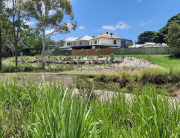The Gold Coast is home to some of the best waterways in the world. Stormwater treatment devices are integrated throughout the city to help protect these waterways, and the appropriate function (and associated performance) of these devices is highly dependent on these assets being appropriately maintained. Clare McAsh is a Senior Environmental Engineer with the City of Gold Coast and is ‘Asset Custodian’ of the city’s wetlands, bioretention systems, sediment basins, infiltration swales and GPTs. Stormwater Queensland’s Brad Dalrymple recently sat down with Clare for a quick Q & A about the City’s maintenance program for these assets.
BD: Can you tell us about the City of Gold Coast’s current maintenance program for Council-owned stormwater treatment devices (e.g. bioretention, wetlands, gross pollutant traps)?
CM: We have two maintenance contracts with external contractors that maintain and repair our WSUD and GPT assets.
The City has just over 300 WSUD assets, which include wetlands, bioretention basins, sediment basins and infiltration swales. WSUD assets are maintained on a monthly basis, with a few assets getting fortnightly or even weekly maintenance visits. The weekly assets are located in Broadwater Parklands, which is a highly visible, aesthetically pleasing and important public park for the City. These assets are now required to be kept at a higher landscape standard, similar to the nearby landscaped garden beds in the Park.
The City has 420 GPT assets (that are the large underground units) and just over 700 simple GPT devices (e.g. gully baskets and trash racks). GPTs are regularly inspected and put on a cleaning program according to those which are 100% full (and subsequently in bypass). Rain events affect this program in that we have high priority units that always fill up after an event so in a program become more urgent to clean out.
I work in the City Assets branch which is a branch of Council specifically for the custodians of City owned assets. We are informed by other branches about assets being handed over and when they are to be officially ours. On occasions, we also spot old assets that have somehow slipped through the systems and not been captured, which is fun – trying to work out what it is, how it should be working and what needs to happen to fix it and have a new shiny WSUD or GPT for my empire!
BD: What sort of resources are involved ?
CM: For the WSUD assets, we have three crews of four people – and landscaping equipment, chemical spray equipment, small plant for minor excavations and sediment removal. For the GPTs, we have four crews of 2 to 4 people (with team size depending on the asset and equipment required).
BD: How much does the maintenance of these devices cost Council ?
CM: The total WSUD and GPT asset maintenance budget per year is $2.3 million. Currently the WSUD budget is deemed enough. More money for the GPT budget would mean greater frequency of cleans and less GPTs sitting full and in bypass.
BD: Where does the funding come from ?
CM: A magical rabbit who appears each year in July with a suitcase of cash, a twinkle in her eye and wearing a jaunty bonnet.
BD: How much pollutants is removed from these devices ?
CM: Approximately 1000m3 of gross pollutants, sediment and vegetation is removed each year via the GPT contract. No work has been done on the amount of N, P and TSS is removed via the WSUDs…perhaps a university project for someone?! 🙂











Leave A Comment
You must be logged in to post a comment.